Abstract
The Cambrian period holds a crucial position in the history of life evolution. The Cambrian strata in the Yangtze Plate is a research hotspot in multiple disciplines and it of great significance for the study of the “Cambrian Explosion”. However, the research on the provenance and the degree of weathering of the sedimentary rocks in the Wulongqing (WLQ) Formation remains insufficient. This study focuses on the Cambrian WLQ Formation in the Yangtze Plate. A total of 26 samples, including sandstone and mudstone, were collected and analyzed using petrographic and geochemical analysis (including major elements, trace elements and rare earth elements) to constraint provenance and paleoweathering. The results show that SiO2, Al2O3, and total Fe2O3 (Fe2O3T) are the main components. The average total concentration of rare earth elements is higher than the average value of the Upper Continental Crust. Through a variety of discrimination methods, such as the ratios of w(SiO2)/w(Al2O3) and w(Al2O3)/w(TiO2), the Zr–TiO2 and Th/Sc–Zr/Sc diagrams, it is indicated that sedimentary rocks and felsic igneous rocks are the main provenances. The paleoweathering was evaluated by Chemical Index of Alteration (CIA), Chemical Index of Weathering (CIW), and Plagioclase Index of Alteration (PIA). The CIA value ranges from 56.08 to 75.92, with average value 68.03, indicating a moderate chemical weathering. After correcting for the K metasomatism during diagenesis, the CIAcorr value indicates that deposition took place various climatic conditions ranging from warm and humid to hot and humid. The CIAcorr value indicated a moderate to strong chemical weathering. These findings provide critical geochemical evidence for deciphering the evolution of the Cambrian paleoenvironment. This study establishes connections to biological events through the disclosure of felsic provenance characteristics within the WLQ Formation and the interpretation of paleoclimatic shifts as evidenced by chemical weathering patterns.
1. Introduction
The Cambrian period (541–485 Ma) stands as a transformative era in Earth’s history, characterized by the “Cambrian Explosion”—an unprecedented diversification of multicellular organisms that reshaped global ecosystems [1,2,3]. The Yangtze Plate in South China harbors one of the most comprehensive Cambrian stratigraphic sequences worldwide, including the Wulongqing (WLQ) Formation, which preserves the iconic Guanshan Biota [4,5]. As a key locus for multidisciplinary investigations, the Yangtze Plate’s Cambrian strata, particularly the WLQ Formation, offer critical insights into paleoenvironmental dynamics, early life evolution, and sedimentary processes.
Previous studies of the Yangtze Plate’s Cambrian strata, including the WLQ Formation, have primarily focused on paleontology, biostratigraphy, and sedimentary environments [6,7,8,9,10,11,12]. One study documented shale-dominated deposits in low-energy shelf and coastal environments, characterized by ripples, bioturbation structures, and fossil assemblages of trilobites and brachiopods. However, despite these advances, understanding of the provenance of the sedimentary rocks of the WLQ Formation and the chemical weathering intensity of the source area is lacking. Such knowledge is essential for reconstructing paleoenvironmental conditions and evaluating their potential links to biological diversification events. The petrographic and geochemical features of clastic sedimentary rocks reflect the characteristics of their sources and are subject to influences such as basin tectonic contexts, properties of the source area, depositional environments, weathering of detrital particles, transportation, sedimentation, and post-sedimentary diagenesis [13,14,15,16,17,18,19,20,21,22]. Specifically, geochemical features have been extensively employed to decipher the composition of source materials [23] and to probe into paleoenvironments and weathering phenomena [24,25]. Consequently, this study delves into the sedimentary geochemical features of the Cambrian Series 2 WLQ Formation in the southwestern Yangtze Plate, China.
The WLQ Formation is studied due to its unique geological attributes. It is widely exposed along the southwestern margin of the Yangtze Plate, with continuous outcrops and a lithological diversity—predominantly shales, siltstones, and sandstones—that provides an ideal archive for tracing provenance and weathering processes. By analyzing these sediments, this study aims to investigate the geochemical signatures and refine our understanding of Cambrian paleoenvironmental dynamics, thereby bridging gaps in the sedimentary history of the WLQ Formation in existing studies. The primary goals of the study encompass: (1) examining the geochemical features of the WLQ Formation in eastern Yunnan; (2) reconstructing the provenance of sedimentary rocks of the WLQ Formation; (3) clarifying the degree of paleoweathering in the source region of the WLQ Formation in the southwestern Yangtze Plate during the early Cambrian.
2. Geologic Background
The eastern Yunnan region was part of the Yangtze Craton during the Precambrian, undergoing multiple tectonic activities that formed a complex metamorphic basement (Figure 1a) [26]. During the Paleozoic Era, this area was in a stable cratonic environment where thousands of meters of marine strata were deposited. These strata were deformed and metamorphosed during the Caledonian orogeny, forming significant tectonic units [27]. The Mesozoic Era witnessed a key phase in the tectonic evolution of eastern Yunnan. The early Triassic was influenced by the Indosinian orogeny, causing the uplift of the Yangtze Craton and the formation of a mixed continental sea and a shelf-slope-trough-trench structure. From the late Triassic to the early Jurassic, the western margin of the Yangtze Craton collided and amalgamated with the Tethyan blocks or island arcs, creating foreland basins and peripheral foreland basins [28]. During the Cenozoic Era, eastern Yunnan maintained an active tectonic state. The collision of the Indian Plate with the Eurasian Plate led to the uplift of the Tibetan Plateau, significantly affecting eastern Yunnan. In this period, the region experienced multiple episodes of tectonic uplift and erosion, sculpting its modern topography [29].
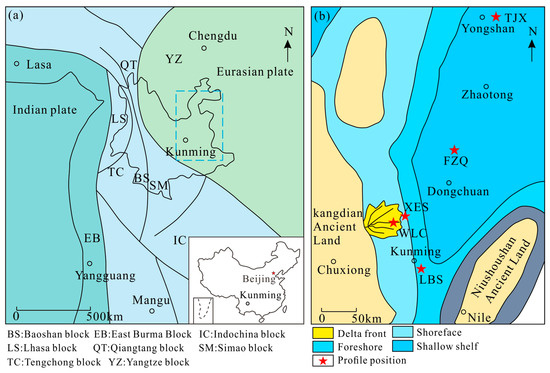
Figure 1.
(a) Tectonic location of the southwestern margin of the Upper Yangtze, (b) Plane sedimentary facies map and profile location map of the WLQ Formation.
The southwestern margin of the upper Yangtze Craton is composed of marine sedimentary strata from the Neoproterozoic Sinian to the Paleozoic Permian and continental sedimentary strata from the Mesozoic to the Cenozoic. The study area’s strata, except for the incomplete development of the Silurian, Cretaceous, and Paleogene, are relatively continuously developed. The WLQ Formation has the largest outcrop area among the Cambrian strata, with wave ripples and bioturbation structures in the strata. Fossils include Redlichia trilobites and brachiopod fossils [10]. The Wulongqing Formation is in integrated contact with the underlying Wujingshao Formation and the overlying Longwangmiao Formation. The Wulongcun (WLC) Section in Wuding County, Chuxiong City, features well-preserved outcrops with distinct stratigraphic boundaries at coordinates 25°34′55″ N and 102°22′49″ E. The WLQ Formation in this section has no top boundary and is dominated by gray-dark gray shale with thin layers of gray-medium grained sandstone. The Xia’ershao (XES) Section in Luquan County, located at 25°39′31″ N and 102°35′5″ E, shows well-exposed outcrops composed mainly of gray-green shales, light-gray limestones, and minor calcareous siltstones. The Tuanjiexiang (TJX) Section in Yongshan County, Zhaotong City, situated at 28°14′20″ N and 103°50′47″ E with an elevation of 447 m, is characterized by medium-bedded gray fine-grained sandstones and siltstones. The Longbaoshan (LBS) Section in Guandu District, Kunming City, at 25°41′2″ N and 102°41′38″ E, displays well-exposed rocks with gentle bedding attitudes, where the WLQ Formation also lacks a visible top boundary and is dominated by gray-black shales and siltstones. The Fengziqing (FZQ) Section in Wuxing Township, Huize County, Qujing City, located at 26°30′55″ N and 103°16′25″ E, exhibits fully exposed WLQ Formation strata with gentle bedding attitudes, primarily composed of gray fine-grained sandstones and siltstones (Figure 1b and Figure 2) [11]. The lithological correlation reveals that the WLQ Formation across the studied sections is dominated by shales and sandstones with variable coloration (gray to dark gray/gray-black) and interbedded lithologies (limestones, calcareous siltstones), reflecting lateral variations in sedimentary environments and depositional conditions.
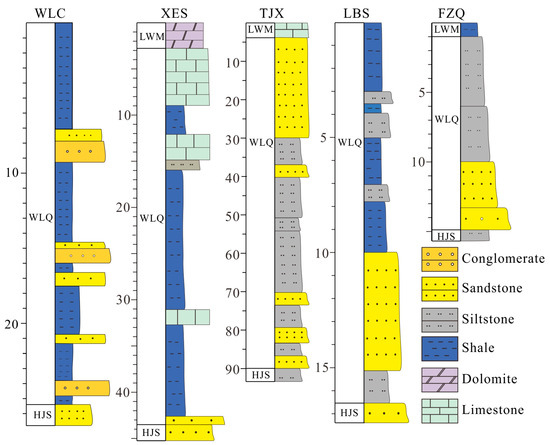
Figure 2.
Stratigraphic columns related to the collected samples. WLC: wulongcun section; XES: xia’ershao section; TJX: tuanjiexiang section; LBS: longbaoshan section; FZQ: fengziqing section; HJS: hongjingshao formation; WLQ: wulongqing formation; LWM: longwangmiao formation.
3. Material and Methods
The Cambrian WLQ Formation along the southwestern margin of the Yangtze Platform exhibits well-exposed strata with distinct boundaries. Fresh outcrop samples were preferentially collected, from the WLQ Formation, with the majority of rocks being sandstone and a minor portion of mudstone, with a total of 26 samples. Five of all samples were processed into standard petrographic thin sections in the laboratory for further research. Each section of at least 500 framework grains > 60 μm was point-counted according to the Gazzi Dickinson standard approach [30,31,32]. Major element analysis was conducted at the State Key Laboratory of Continental Dynamics, Northwest University. Prior to analysis, samples were crushed in the laboratory—first coarsely and then finely. Coarse crushing was performed using a contamination-free jaw crusher, reducing samples with diameters ≤80 mm to 2–5 mm (10–20 mesh). After each coarse crushing, the crusher was wiped with water and then with a 75% ethanol solution to prevent contamination. Fine crushing involved placing samples in a tungsten carbide tray and then into a vibrating disk mill for pulverization to a size suitable for elemental and isotopic analysis, typically less than 0.074 mm (200 mesh). After each fine crushing, the tungsten carbide tray was cleaned with water and wiped with a 75% ethanol solution to ensure no cross-contamination between samples.
The main element test instrument is a RIGAKU RIX2100 scanning automatic X-ray fluorescence spectrometer. The powdered whole-rock samples, ground to 200 mesh, were first dried at 105 °C for 4 h and then stored in a desiccator. Subsequently, 1.2–1.4 g of the powdered samples were weighed using clean ceramic crucibles that had been wiped with alcohol. These samples were then ashed in a high-temperature furnace at 925 °C for approximately 3–4 h. After cooling, the loss on ignition was determined. The cooled powder samples were mixed with a flux (lithium metaborate), a fusion aid (lithium fluoride), and an oxidizer (ammonium nitrate) in specified proportions, and then placed in platinum crucibles. A few drops (2–3) of a 1.5% mold-release agent solution (lithium bromide) were added, and the crucibles were melted in a high-frequency melting machine at 1200 °C. Afterward, the crucibles were allowed to cool on a flat surface to form brown or yellow-brown glass disks. These uniformly colored glass disks were then subjected to major element analysis using the RIGAKU RIX2100 X-ray fluorescence spectrometer [33].
The analysis of trace elements and rare earth elements was carried out in the Analysis and Test Center of Beijing Institute of Uranium Geology. The analysis was performed using an ELEMENT XR Inductively Coupled Plasma Mass Spectrometer (ICP-MS), which offers higher sensitivity than traditional quadrupole ICP-MS instruments and operates in low, medium, and high mass resolution modes. Before analyzing each sample, potential surface contamination was removed. Each analytical point involved a 20 s background collection followed by a 30 s laser ablation. During the analysis, USGS reference materials BCR-2G, BHVO-2G, and GSD-1G were used for calibration, and TB-1G was employed as a monitoring standard. The majority of elemental assays were within an error margin of less than 10%. For detailed experimental procedures, see [34].
The chemical weathering of source rocks is evaluated using the chemical index of alteration proposed by Nesbitt and Young [25], the chemical index of weathering which removes K2O to eliminate the influence of potassium metasomatism [35] and the plagioclase index of alteration which adjusts the K2O and Al2O3 contribution from potassium feldspar and monitors the degree of plagioclase weathering that has been successfully used for the reconstruction of paleoweathering [36,37,38].
These proxies are defined using the following formulas:
CIA = 100 × Al2O3/(Al2O3 + CaO* + Na2 O + K2O),
CIW = 100 × Al2O3/(Al2O3 + CaO* + Na2O),
PIA = 100 × (Al2O3 − K2O)/(Al2O3 + CaO* + Na2O − K2O).
CaO* represents the fraction of CaO in silicate minerals, which is used in place of total CaO to avoid the contribution of CaO from carbonate and phosphate minerals that are not linked to weathering processes [24]. CaO* is derived using the following formula (in moles): CaO* = CaO − (10/3) × P2O5. If CaO* was less than the moles of Na2O, this CaO value was adopted. Otherwise, CaO* was assumed to be equivalent to Na2O [39,40].
4. Results
4.1. Sandstone Composition
Sandstone is predominantly composed of quartz, feldspar, and rock fragments, with quartz being the most abundant, consistent with its high content of SiO2 (silicon dioxide) as the primary mineral constituent. The feldspar is primarily composed of potassium feldspar and sodium feldspar, while the lithic fragments include clastic sedimentary and igneous rock fragments (Figure 3). On the Qt-F-L and Qm-F-Lt tectonic discrimination diagrams, modal data generally plot within or close to the area of “recycled orogen provenances” (Figure 4a,b). Grain types, modal parameters, point-counting results, and recalculated data are listed in Table 1. Representative photomicrographs are shown in Figure 3. The statistic results are further plotted on the Qm-F-L, Qm-F-Lt, and Qp-Lv-Ls ternary diagrams (Figure 4) to illustrate the tectonic relations with provenances [16].
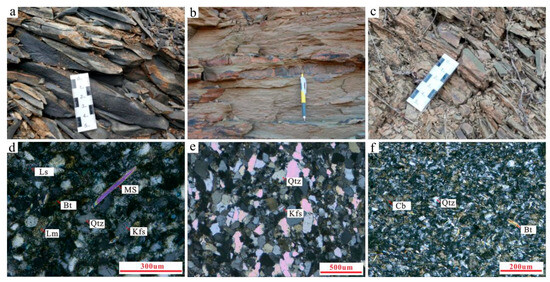
Figure 3.
Representative macro and micro photographs of WLQ strata in the sampling Section. (a). Silty shale, FZQ section; (b). Gray mudstone interbedded with thin lenticular sandstone, LBS section; (c). Gray-green shale, XES section; (d). Siltstone, FZQ section; (e). Fine-grained quartz sandstone, LBS section; (f). Fine-silt-grained quartz sandstone, XES section. Quartz (Qtz); K-feldspar (Kfs); Carbonate mineral (Cb); Muscovite (Ms); Biotite (Bt); Metamorphic rock fragments (Lm); Sedimentary rock fragments (Ls).
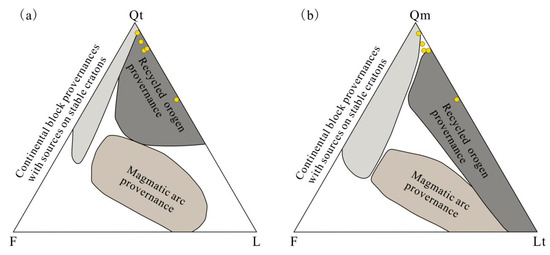
Figure 4.
Ternary plots for the Carboniferous–Permian sandstone modal composition data from the North Qaidam tectonic belt. Provenance fields are from Dickinson and Suczek [16]. (a): Triangular QtFL plot; (b): Triangular QmFLt plot. Qt-total quartz; Qm-monocrystalline quartz; K-K-feldspar; Pl-plagioclase; L-lithic fragment; Qt-Qm + Qp; F-K + Pl; Lt-L + Qp.

Table 1.
Point counting results and recalculated modal data for framework grain composition of the sandstones from the WLQ Formation.
4.2. Major Elements
The chemical composition of major elements in the WLQ Formation is summarized in Table 2. The samples are primarily composed of SiO2, Al2O3, and total Fe2O3 (Fe2O3T). SiO2 constitutes the most abundant component, with concentrations ranging from 31.86 to 79.78 wt% and an average of 61.23 wt%. Al2O3 levels vary between 3.09 and 20.69 wt%, while Fe2O3T concentrations span from 2.03 to 10.39 wt%, averaging 5.56 wt%. In addition, CaO content in the study area ranges from 0.05 to 19.65 wt%, with a mean value of 2.11 wt%, and MnO content is found to be between 0.01 and 0.12 wt%, averaging 0.04 wt%. These compositional variations highlight the heterogeneous nature of the WLQ Formation. The average content of SiO2 in the clastic rock samples of the WLQ Formation is 61.23%, which is lower than that of the Upper Continental Crust (UCC: 66.62 wt.%) [41]. The content of K2O is 1.51%~6.95%, with an average of 5.08%, and the content of most samples is higher than that of UCC 3.19%. Its relatively high content may be related to K metasomatism during diagenesis [11].

Table 2.
Major elements (%) and chemical weathering index of the WLQ Formation rock.
The correlation analysis between the major elements of the samples (Table 3) shows that Fe2O3T and Al2O3 have a good positive correlation (correlation coefficient is 0.73), and SiO2 and MgO have a good negative correlation (correlation coefficient is −0.86). SiO2 is negatively correlated with Fe2O3T, MgO and MnO, indicating a certain particle size effect [39], while MgO, CaO and MnO are positively correlated with each other, and the correlation coefficient between MgO and MnO is 0.4; the correlation coefficient between CaO and MnO is 0.64. The correlation coefficient between MgO and CaO is 0.8.

Table 3.
Correlation analysis table of major elements.
4.3. Trace Elements
The concentrations of trace elements in the samples from the WLQ Formation are presented in Table 4. To comprehensively analyze the enrichment characteristics of these elements, the trace elements in the WLQ Formation samples were normalized against the Upper Continental Crust (UCC) standards. The resulting normalization spider diagrams are depicted in Figure 5 detailed examination of these diagrams reveals that, in contrast to the Upper Continental Crust, elements such as Li, Co, Y, Cs, and U exhibit relatively higher enrichment levels within the WLQ Formation samples. Conversely, the element Sr displays a relatively depleted state, as clearly illustrated in Figure 5. This distinct pattern of element enrichment and depletion provides crucial insights into the geochemical processes and source characteristics associated with the WLQ Formation.

Table 4.
Trace and rare earth element concentrations, ppm.
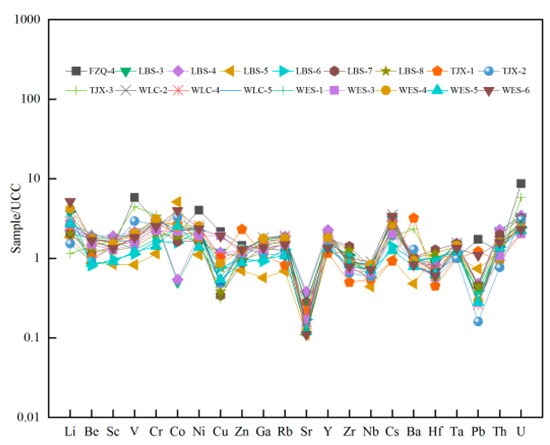
Figure 5.
The standardized spider diagram of trace elements in the upper continental crust of the WLQ Formation.
4.4. Rare Earth Elements
Table 4 presents the concentrations of rare-earth elements (REEs) in the WLQ Formation. The average total concentration of REEs (∑REE) is precisely measured at 210.85 ppm. Notably, this value is substantially higher than that of the Upper Continental Crust (UCC), which has an average value of 146.37 ppm. In terms of the classification of REEs, the total concentration of light rare-earth elements (ΣLREE) in the WLQ Formation fluctuates within the range of 66.28 ppm to 276.90 ppm, with an average value of 180.23 ppm. This accounts for approximately 85% of the ∑REE. The total concentration of heavy rare-earth elements (ΣHREE) in the WLQ Formation ranges from 6.57 ppm to 21.46 ppm, with an average of 14.68 ppm, contributing roughly 6% to the ∑REE. Regarding the middle rare-earth elements (ΣMREE), their concentration is between 7.37 ppm and 23.91 ppm, with an average of 15.93 ppm.
In this research, the rare earth element (REE) compositions of samples from the WLQ Formation were analyzed in detail using normalization models based on the Upper Continental Crust (UCC) and chondrites. The graphical depictions of the UCC—normalized and chondrite—normalized patterns are presented in Figure 6. After comprehensive examination, it is clear that the REE compositions of the WLQ Formation samples bear a strong similarity to those of the Upper Continental Crust. It is worth noting that the total rare earth elements in most samples show a slight enrichment state, as shown in Figure 6A. When the data are normalized to chondrites, the resulting pattern curves display a distinct “right-leaning” feature. This particular pattern clearly indicates the relative enrichment of light rare-earth elements (LREEs) and a relatively flat profile for heavy rare-earth elements (HREEs), as presented in Figure 6B. These results not only contribute to a deeper understanding of the geochemical signatures within the WLQ Formation but also have the potential to offer valuable insights into the underlying geological processes and evolutionary history related to this formation.

Figure 6.
(A): UCC-normalized REE distribution patterns of samples from the WLQ Formation; (B): Chondrite-normalized REE distribution patterns of samples from the WLQ Formation.
5. Discussion
5.1. Provenance
It has been demonstrated that the chemical composition of siliciclastic sedimentary rocks is related to that of their source regions and can be used to characterize the source rocks from which the investigated siliciclastic sedimentary rocks were derived [42,43,44,45]. Bhatia and Crook [46] found that siliciclastic rocks deposited in various tectonic environments differ markedly in major element compositions. This holds true also for limestones [47]. In the analyzed samples, the ratio of the mass fraction of SiO2 to that of Al2O3, denoted as w(SiO2)/w(Al2O3), is in the range from 2.71 to 11.22, with an average value of 4.59. This average value is marginally higher than the average ratio of the continental crust, which is 3.6 [41]. Such a result strongly suggests that the sediments were predominantly sourced from continental clastic materials [48,49,50]. Wang et al. revealed transgressive-regressive cycles and the formation of clastic tidal flat environments in the Wulongqing Member through facies analysis [48], while Li et al. further proposed that rift trough shrinkage enhanced terrigenous clastic input [49], collectively supporting the dominance of continental clastic materials. Notably, the clastic-carbonate mixed lithology reported by Tong et al. [50] contrasts with our findings, likely due to sampling location differences—our study focused on marginal clastic depositional areas, whereas Tong et al. concentrated on carbonate platform-proximal regions. The ratio of w(Al2O3)/w(TiO2) in most clastic rocks serves as a crucial geochemical indicator for inferring the compositions of source rocks. Specifically, for mafic igneous rocks, the w(Al2O3)/w(TiO2) ratio typically ranges from 3 to 8; for intermediate igneous rocks, it ranges from 8 to 21; and for felsic igneous rocks, it ranges from 21 to 70 [51]. In the case of the WLQ Formation, the w(Al2O3)/w(TiO2) ratio varies between 11.29 and 25.25, with an average of 19.97. Among the samples, 12 samples exhibit values less than 21, while 9 samples have values greater than 21. This distribution implies that the source rocks of the WLQ Formation shows a provenance from felsic and intermediate igneous rocks, respectively.
The Zr–TiO2 diagram represents a powerful geochemical tool for discriminating the provenance of sedimentary rocks [51]. When applied to the WLQ Formation, the Zr–TiO2 diagram clearly demonstrates that the source region of detritus is primarily attributed to the erosion of felsic igneous rocks (Figure 7a). This graphical analysis provides a direct and intuitive means of identifying the origin of the sedimentary materials, highlighting the significance of felsic igneous rocks in contributing to the detritus within the WLQ Formation. In addition, the Th/Sc vs. Zr/Sc plot (Figure 7b), serves as another valuable proxy for inferring the provenance of the WLQ Formation [15]. The distribution of samples within the felsic field of this plot strongly suggests that felsic rocks are likely the dominant source of the sediments. This finding is consistent with the evidence from the Zr–TiO2 diagram, further corroborating the significant role of felsic igneous rocks in shaping the sedimentary composition of the WLQ Formation. Furthermore, it is well established that sedimentary rocks typically exhibit a low Zr/Sc ratio, which indicates that the composition of clastic sedimentary rocks is predominantly controlled by the composition of the source rocks, rather than by the cyclic modification of sedimentary materials during the sedimentary process [52].
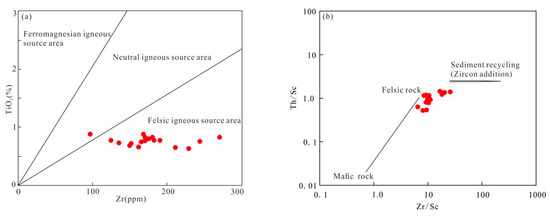
Figure 7.
Provenance discrimination diagrams: (a) TiO2 vs. Zr; (b) Th/Sc vs. Zr/Sc.
Previous research results have shown that the major element composition of clastic sedimentary rocks is also greatly related to the composition of the source rocks area, and major element related discriminant diagrams have also been well applied in the analysis of source rock composition characteristics [44,53]. Moreover, Roser and Korsch [54] devised discriminant functions of F1 to F2 and F3 to F4 for determining the provenance of the WLQ Formation. With the exception of two samples situated in the felsic igneous rock source area (Figure 8a) and one sample in the neutral igneous rock source area (Figure 8b), the majority of the samples within the WLQ group are positioned in the quartzite sediment source zone [54]. These results indicate that there existed a relatively stable material source during the depositional period of the WLQ Formation.
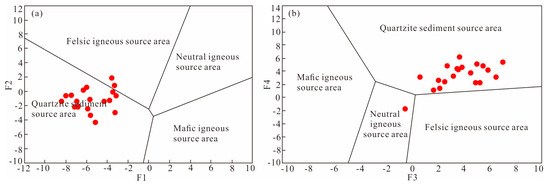
Figure 8.
Source region discrimination based on principal element analysis: (a). F1 vs. F2; (b). F3 vs. F4.
During the transportation and deposition processes, rare earth elements, as well as relatively stable trace elements such as Co, Th, Sc, and Zr, are minimally influenced by other factors. Given their short residence time in the transporting water body, a substantial portion of these elements will be transferred and deposited within sediments [55]. Sedimentary rocks are capable of effectively preserving these stable trace elements and rare earth elements. Consequently, the composition of the source rock can be reconstructed through the analysis of relevant trace elements. Rare earth elements possess relatively stable chemical properties and undergo minimal changes during sediment transportation, deposition, and diagenesis, with only minor fractionation occurring. Thus, the rare earth elements in sedimentary rocks can effectively retain the source rock information related to hydrocarbon sources [56].
As can be observed from the La/Yb—∑REE diagram (Figure 9a), the sedimentary rock samples in the study area are predominantly distributed within the sedimentary rock and granite regions, while some samples are located in the alkaline basalt and continental tholeiite regions. It can be deduced that the source rock of the WLQ Formation sedimentary rocks is likely to be predominantly composed of sedimentary rock and granite, with a basaltic component within the sedimentary rocks. From the La/T–Hf diagram (Figure 9b), it is evident that the samples are mainly concentrated in the acidic arc source area and the mixed felsic–basic source area. This indicates that the source rock is primarily felsic rock, with the inclusion of basaltic rock components.
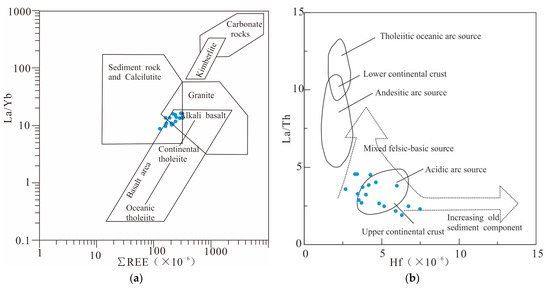
Figure 9.
(a) Discrimination diagrams for the provenance attributes of the sample in the WLQ Formation; (b) Discriminant map of sedimentary rock provenance properties, La/Th vs. Hf.
Based on the foregoing geochemical analyses, it can be firmly concluded that the source rocks of the clastic rocks within the WLQ Formation in the study area are predominantly sedimentary rocks and felsic volcanic rocks. This finding is highly consistent with the provenance characteristics of the uplifted granites and sedimentary rocks that are rich in felsic minerals, which were present in the Kangdian ancient land to the west of the Yangtze plate during the Early Cambrian period [52].
5.2. Paleoweathering
Major element oxide data are frequently utilized to calculate chemical weathering indices, including the Chemical Index of Alteration (CIA), Plagioclase Index of Alteration (PIA), and Chemical Index of Weathering (CIW). These indices are used to characterize the weathering profile and evaluate the intensity of chemical weathering processes.
All samples collected from the WLQ Formation along the southwestern margin of the Yangtze Platform, comprising both sandstone and mudstone, exhibit Chemical Index of Alteration (CIA) values ranging from 56.08 to 75.92 (average: 68.03), Chemical Index of Weathering (CIW) values between 68.73 and 98.40 (average: 68.73), and Plagioclase Index of Alteration (PIA) values from 59.79 to 97.67 (average: 88.08). A strong correlation among CIA, PIA, and CIW values is evident (Figure 10). These indices collectively indicate a moderate level of chemical weathering, consistent with warm and humid paleoclimatic conditions in the region [49,50].
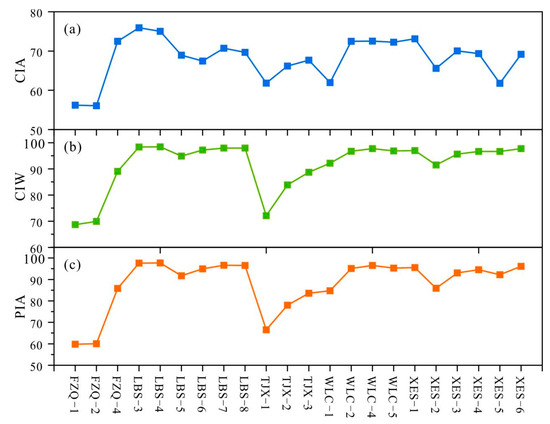
Figure 10.
Distribution of CIA, PIA and CIW values of WLQ Formation in the study area. (a): CIA values, (b): CIw values, (c): PIA values.
If there is K metasomatism in sedimentary rocks during diagenesis, K metasomatism will increase the content of K elements in sedimentary rocks, resulting in low CIA values. Therefore, it is necessary to calculate the CIA value without K metasomatism. This paper uses the modified CIA (CIAcorr) method proposed by Panahi et al. [57]:
CIAcorr = [Al2O3/(Al2O3 + CaO* + Na2O + K2Ocorr)] × 100,
K2Ocorr = [m∙Al2O3 + m∙(CaO* + Na2O)]/(1 − m),
m = K2O/(Al2O3 + CaO* + Na2O + K2O).
The CIAcorr values of the 22 sedimentary rock samples in the WLQ Formation in the study area are 61.18–87.59, with an average of 81.54. Among them, the CIAcorr values of 13 samples are greater than 80, which generally reflects the degree of moderate to strong weathering under warm and humid to hot and humid paleoclimatic conditions.
The A-CN-K diagram (Figure 11a) reveals that the weathering trend line of WLQ Formation samples deviates toward the K apex, contrasting with the ideal weathering trend, which should align parallel to the A-CN edge [40]. Comparative analysis between the WLQ Formation samples and the Upper Continental Crust (UCC) indicates significant potassium (K) enrichment. This suggests the occurrence of K-metasomatism during the diagenetic processes of sedimentary rocks in the study area, which elevates K content and consequently reduces the Chemical Index of Alteration (CIA) values. After correcting the K2O content using Formulas (4)–(6), the WLQ Formation sedimentary rock samples plot within the moderate to strong chemical weathering range in the A-CN-K diagram (Figure 11b). The adjusted weathering trend line aligns nearly parallel to the A-CN edge and is positioned between granodiorite and andesite, closer to granodiorite. This finding further supports the conclusion that felsic igneous rocks constitute one of the primary provenances, aligning well with the earlier analysis.

Figure 11.
Ternary diagrams of A-CN-K for the WLQ Formation samples. (a) Before correction, (b) After correction; Abbreviations: A—Al2O3, CN—CaO*+ Na2O, K—K2O.
5.3. Implications for Paleoenvironment Reconstruction
The lithological assemblages (shales, siltstones, and fine-grained sandstones) of the Wulongqing Formation exhibit a strong coupling relationship with chemical weathering intensity. Mudstone samples yield a higher mean corrected Chemical Index of Alteration compared to sandstones, indicating that fine-grained sediments underwent more intense chemical weathering during transportation and deposition. This pattern aligns with sedimentary structures (e.g., wave ripples, bioturbation), suggesting deposition in low-energy shelf environments where prolonged weathering occurred [12]. Notably, the moderate-to-strong chemical weathering intensity implies that hot-humid climates not only enhanced chemical weathering but also promoted terrestrial organic input and preservation, potentially fostering favorable conditions for early Cambrian biological diversification [5].
Tectonically, the felsic-dominated provenance of the Wulongqing Formation supports the Kangdian Old Land as a major source of granitic detritus, consistent with regional models of Early Cambrian crustal uplift along the southwestern Yangtze Plate [52]. This felsic signature not only matches the granitic supply from the Kangdian Old Land but also inherits provenance characteristics from the underlying Qiongzhusi Formation (felsic-dominated provenance [52,58]), highlighting the stability of the sedimentary system from the Qiongzhusi to Canglangpu depositional periods. Compared to coeval Cambrian successions in the Sichuan Basin (intermediate-felsic magmatic rocks with minor mafic contributions [59,60]), the Wulongqing Formation exhibits stronger chemical weathering and a more felsic-rich provenance, reflecting its proximity to the Kangdian Old Land and distinct paleoclimatic conditions.
6. Conclusions
The main components of the WLQ Formation are SiO2, Al2O3 and Fe2O3T, with the average values of 61.23%, 15.14% and 5.56%, respectively. The total concentration of rare earth elements of WLQ Formation is 210.85 ppm, which is higher than that of UCC (average 146.37 ppm).
The ratios of w(SiO2)/w(Al2O3), w(Al2O3)/w(TiO2), the Zr-TiO2 diagram, the Th/Sc vs. Zr/Sc plot, the discriminant function of F1 vs. F2 and F3 vs. F4, and the discrimination diagram of the total concentration of REE vs. La/Yb indicated that sedimentary and felsic igneous rocks are the main provenances of the WLQ Formation.
The chemical weathering index indicates that the sandstone of the WLQ Formation has experienced secondary potassium enrichment, and after correction indicates that the degree of weathering of the WLQ Formation is moderate to strong under the paleoclimate condition of warm-wet to hot-wet. In addition, the coupling relationship between the dynamic changes in paleo-weathering intensity and the sedimentary environment provides a key clue for understanding the environmental driving mechanism of the Cambrian bioexplosion.
Author Contributions
Conceptualization, Z.F. and X.P.; validation, H.L., Q.C. and B.H.; investigation, J.D. and Y.L.; resources, L.G.; writing—original draft preparation, Z.F.; writing—review and editing, Z.F.; supervision, L.G.; funding acquisition, L.G. All authors have read and agreed to the published version of the manuscript.
Funding
This research was funded by the National Natural Science Foundation of China (No. 41302076).
Data Availability Statement
Data are contained within the article.
Acknowledgments
Thanks are due to reviewers for their abundant critical and constructive comments.
Conflicts of Interest
Authors H.L., Q.C., B.H., J.D. and Y.L. were employed by the company No.2 Gas Production Plant, Changqing Oilfield Company of PetroChina. The remaining authors declare that the research was conducted in the absence of any commercial or financial relationships that could be construed as a potential conflict of interest.
References
- Yeasmin, R.; Chen, D.; Fu, Y.; Wang, J.; Guo, Z.; Guo, C. Climatic-oceanic forcing on the organic accumulation across the shelf during the Early Cambrian (Age 2 through 3) in the mid-upper Yangtze Block, NE Guizhou, South China. J. Asian Earth Sci. 2017, 134, 365–386. [Google Scholar] [CrossRef]
- Zhu, M.Y.; Zhao, F.C.; Yin, Z.J.; Zeng, H.; Li, G.X. Research on the Cambrian Explosion in China: Progress and Prospects. Sci. Sin. Terrae 2019, 49, 1455–1490. [Google Scholar]
- Ye, Y.; Wang, H.; Wang, X.; Zhai, L.; Wu, C.; Canfield, D.E.; Zhang, S. Tracking the evolution of seawater Mo isotopes through the Ediacaran-Cambrian transition. Precambrian Res. 2020, 350, 105929. [Google Scholar]
- Yang, Z.; Wu, P.; Fu, Y.; Qiao, W.; Qin, Y.; Li, C.; Xia, P.; Guo, C.; Long, X.; Wu, L. Coupling of the redox history and enrichment of Ni-Mo in black shale during the early Cambrian: Constraints from S-Fe isotopes and trace elements of pyrite, South China. Ore Geol. Rev. 2022, 143, 104749. [Google Scholar]
- Shu, D.G.; Han, J. Core value of the Chengjiang fauna: Formation of the animal kingdom and the birth of basic human organs. Earth Sci. Front. 2020, 27, 382–412. [Google Scholar]
- Zhang, X.L. Marine refractory dissolved organic carbon pool and transgressive black shale. Chin. Sci. Bull. 2021, 67, 1607–1613. [Google Scholar]
- Luo, H.L.; Tao, Y.H.; Gao, S.M. Trace fossils of the Early Cambrian near Kunming. Acta Palaeontol. Sin. 1994, 6, 676–685. [Google Scholar]
- Ren, Y.; Shi, G.; Qiao, D.; Zhang, Z.Y.; Tao, J.; Wang, Y.D. Characteristics of trilobite fossils in the Canglangpu Formation of the Fourth Stage of the Cambrian Series 2 in Huize, Yunnan. Jiangxi Sci. 2020, 38, 63–68. [Google Scholar]
- Ma, S.Y.; Xie, W.R.; Yang, W.; Duan, S.F.; Wang, Z.C.; Wu, S.J.; Su, N.; Hao, C.G.; Wang, X.D. Lithofacies palaeogeographical characteristics of the lower member of the Cambrian Canglangpu Formation in the Sichuan Basin and its periphery. Nat. Gas Geosci. 2021, 32, 1324–1333. [Google Scholar]
- Zhao, W.Y. Study on Trilobites of the Guanshan Biota in Yunnan. Master’s Thesis, Northwest University, Xi’an, China, 2021. [Google Scholar]
- Peng, X.X. Sedimentary Geochemistry and Palaeoenvironment Reconstruction of the Cambrian Canglangpu Formation on the Southwestern Margin of the Upper Yangtze. Master’s Thesis, Northwest University, Xi’an, China, 2022. [Google Scholar]
- Wen, J.; Peng, J.; Chen, Y.; Chu, J.; Deng, S.; Dai, X. Sequence stratigraphy and sedimentary characteristics of the Cambrian Canglangpu Formation in the Sutian section, Yongshan County, Yunnan Province. J. Stratigr. 2020, 44, 268–276. [Google Scholar]
- Mclennan, S.M. Relationships between the trace element composition of sedimentary rocks and upper continental crust. Geochem. Geophys. Geosyst. 2001, 2, 1021–1024. [Google Scholar]
- Moosavirad, S.M.; Janardhana, M.R.; Sethumadhav, M.S.; Moghadam, M.R.; Shankara, M. Geochemistry of lower Jurassic shales of the Shemshak formation, Kerman province, central Iran: Provenance, source weathering and tectonic setting. Geochemistry 2011, 71, 279–288. [Google Scholar]
- McLennan, S.M.; Hemming, S.; McDaniel, D.K.; Hanson, G.N. Geochemical Approaches to Sedimentation, Provenance, and Tectonics. In Processes Controlling the Composition of Clastic Sediments; Geological Society of America Special Papers: Boulder, CO, USA, 1993; Volume 284, pp. 21–40. [Google Scholar]
- Dickinson, W.R.; Suczek, C.A. Plate tectonics and sandstone compositions. Am. Assoc. Petrol. Geol. Bull. 1979, 63, 2164–2182. [Google Scholar]
- Cullers, R.L. The controls on the major and trace element variation of shales, siltstones, and sandstones of Pennsylvanian-Permian age from uplifted continental blocks in Colorado to platform sediments in Kansas, USA. Geochim. Cosmochim. Acta 1994, 58, 4955–4972. [Google Scholar]
- Perri, F. Composition, provenance and source weathering of Mesozoic sandstones from Western-Central Mediterranean Alpine Chains. J. Afr. Earth Sci. 2014, 91, 32–43. [Google Scholar]
- Zhao, Y.; Liu, C.Y.; Zhang, D.D.; Deng, H.; Zhao, X.C. Petrography and geochemistry of the Paleogene sandstones from the Ningnan basin, NW China: Implications for provenance, weathering and tectonic setting. Arab. J. Geosci. 2016, 9, 68. [Google Scholar]
- Le Pera, E.; Tangari, A.C.; Marinangeli, L.; Morrone, C.; Riber, R.; Ando, S. Provenance of modern sands from Baja California rivers (Mexico): Petrographic constraints from light and heavy minerals. J. Sediment. Res. 2023, 93, 617–641. [Google Scholar] [CrossRef]
- Bela, V.A.; Bessa, A.Z.E.; Armstrong-Altrin, J.S.; Kamani, F.A.; Nya, E.D.B.; Ngueutchoua, G. Provenance of clastic sediments: A case study from Cameroon, Central Africa. Solid Earth Sci. 2023, 8, 105–122. [Google Scholar]
- Pasqualone, L.; Brozzetti, F.; Mirabella, F.; Luchetti, L.; Tangari, A.C.; Barchi, M.R. Tectono-stratigraphic evolution of a deep-water foreland basin: A case study from the Marnoso-arenacea basin, central Italy. Ital. J. Geosci. 2024, 143, 105–129. [Google Scholar]
- Condie, K.C. Chemical composition and evolution of the upper continental crust: Contrasting results from surface samples and shales. Chem. Geol. 1993, 104, 1–37. [Google Scholar]
- Nesbitt, H.W.; Young, G.M. Early Proterozoic climates and plate motions inferred from major element chemistry of lutites. Nature 1982, 299, 715–717. [Google Scholar]
- Nesbitt, H.W.; Young, G.M. Formation and diagenesis of weathering profiles. J. Geol. 1989, 97, 129–147. [Google Scholar]
- Bai, L.X.; Zhu, R.X. Review of Paleozoic tectonic evolution and paleomagnetic studies of the Yangtze Block. Prog. Geophys. 1996, 3, 109–114+116. [Google Scholar]
- Liu, H.R.; Huang, X.B. Sequence stratigraphy of the Late Proterozoic—Paleozoic on the eastern margin of the Kangdian Old Land. Acta Geol. Sichuan 1996, 2, 115–119. [Google Scholar]
- Zhou, X.B.; Li, J.H.; Wang, H.H.; Li, W.S. Reconstruction of Cambrian global paleo-plates and paleogeography. Mar. Orig. Petrol. Geol. 2014, 19, 1–7. [Google Scholar]
- Cheng, Y.; Jian, L.; Tang, G.; Zhang, C.Y. Trace Element Anomaly Characteristics and Metallogenic Significance of the Lower Cambrian Qiongzhusi Formation from Huize Area, Eastern Yunnan Province. Nonferr. Met. Eng. 2020, 10, 90–98. [Google Scholar]
- Ingersoll, R.V.; Fullard, T.F.; Ford, R.L.; Grimm, J.P.; Pickle, J.D.; Sares, S.W. The effect of grain size on detrital modes: A test of the Gazzi-Dickinson point–counting method. J. Sediment. Res. 1984, 54, 103–116. [Google Scholar]
- Dickinson, W.R. Provenance of Arenites. In Interpreting Provenance Relations from Detrital Modes of Sandstones; Springer: Dordrecht, The Netherlands, 1985; pp. 333–361. [Google Scholar]
- Dickinson, W.R. Interpreting detrital modes of graywacke and arkose. J. Sediment. Petrol. 1970, 40, 695–707. [Google Scholar]
- Wang, J.Q.; Liu, X.M. Proficiency testing of the determination of ten major elements in different types of rocks by X-ray fluorescence spectrometry. Rock Miner. Anal. 2016, 35, 145–151. [Google Scholar]
- Zhang, L.; Ren, Z.Y.; Xia, X.P.; Yang, Q.; Hong, L.B.; Wu, D. In situ determination of trace elements in melt inclusions using laser ablation inductively coupled plasma sector field mass spectrometry. Rapid Commun. Mass Spectrom. 2019, 33, 361–370. [Google Scholar]
- Harnois, L. The CIW index: A new chemical index of weathering. Sediment. Geol. 1988, 55, 319–322. [Google Scholar]
- Guo, L.; Jia, C.C.; Du, W. Geochemistry of Lower Silurian shale of Longmaxi Formation, southeastern Sichuan Basin, China: Implications for provenance and source weathering. J. Cent. South Univ. 2016, 23, 669–676. [Google Scholar]
- Liu, S.; Liu, B.; Tang, S.; Zhao, C.; Tan, F.; Xi, Z.; Du, F. Palaeoenvironmental and tectonic controls on organic matter enrichment in the Middle Jurassic Dameigou Formation (Qaidam Basin, North China). Palaeogeogr. Palaeoclimatol. Palaeoecol. 2022, 585, 110747. [Google Scholar]
- Deng, T.; Li, Y.; Wang, Z.; Yu, Q.; Dong, S.; Yan, L.; Hu, W.; Chen, B. Geochemical characteristics and organic matter enrichment mechanism of black shale in the Upper Triassic Xujiahe Formation in the Sichuan basin: Implications for paleoweathering, provenance and tectonic setting. Mar. Petrol. Geol. 2019, 109, 698–716. [Google Scholar]
- Fedo, C.M.; Nesbitt, H.W.; Young, G.M. Unraveling the effects of potassium metasomatism in sedimentary rocks and paleosols, with implications for paleoweathering conditions and provenance. Geology 1995, 23, 921–924. [Google Scholar]
- McLennan, S.M. Weathering and global denudation. J. Geol. 1993, 101, 295–303. [Google Scholar]
- Taylor, S.R.; McLennan, S.M. The Continental Crust: Its Composition and Evolution; Blackwell: Hoboken, NJ, USA, 1985. [Google Scholar]
- Garver, J.I.; Royce, P.R.; Smick, T.A. Chromium and nickel in shale of the Taconic foreland; a case study for the provenance of fine-grained sediments with an ultramafic source. J. Sediment. Res. 1996, 66, 100–106. [Google Scholar]
- Paikaray, S.; Banerjee, S.; Mukherji, S. Geochemistry of shales from the Paleoproterozoic to Neoproterozoic Vindhyan Supergroup: Implications on provenance, tectonics and paleoweathering. J. Asian Earth Sci. 2008, 32, 34–48. [Google Scholar]
- Floyd, P.A.; Leveridge, B.E. Tectonic environment of the Devonian Gramscatho basin, south Cornwall: Framework mode and geochemical evidence from turbiditic sandstones. J. Geol. Soc. 1987, 144, 531–542. [Google Scholar]
- Ghosh, P.; Bhattacharya, S.K.; Dayal, A.M.; Trivedi, J.R.; Ebihara, M.; Sarin, M.M.; Chakrabarti, A. Trace element and isotopic studies of Permo-Carboniferous carbonate nodules from Talchir sediments of peninsular India: Environmental and provenance implications. Proc. Indian Acad. Sci.-Earth Planet. Sci. 2002, 111, 87–93. [Google Scholar]
- Bhatia, M.R.; Crook, K.A.W. Trace element characteristics of graywackes and tectonic setting discrimination of sedimentary basins. Contrib. Mineral. Petrol. 1986, 92, 181–193. [Google Scholar] [CrossRef]
- Zhang, K.J. A Mediterranean-style model for early Neoproterozoic amalga-mation of South China. J. Geodyn. 2017, 105, 1–10. [Google Scholar] [CrossRef]
- Wang, Z.; Zeng, H.; Qu, H.; Zhao, R.; Zhang, Y.; Li, W.; Tang, S.; Zhang, Y. Sedimentary evolution of Cambrian Canglangpu Formation in the northern area of Zhangyunfeng Sichuan Basin. Fault-Block Oil Gas Field 2023, 30, 808–815. [Google Scholar]
- Li, Y.; Chen, Y.; Yan, W.; Dai, R.; Xi, C. Sedimentary evolution characteristics of Cambrian Canglangpu Formation in Heyuan Sichuan Basin. Nat. Gas Geosci. 2021, 32, 1334–1346. [Google Scholar]
- Tong, Z.; Hu, Z.; Li, S.; Huang, Y.; Zuo, Y.; Zhu, Y.; Pang, Y.; Dong, Q.; Xu, C. Silicate and Carbonate Mixed Shelf Formation and Its Controlling Factors, a Case Study from the Cambrian Canglangpu Formation in Sichuan Basin, China. Open Geosci. 2023, 15, 20220480. [Google Scholar]
- Hayashi, K.I.; Fujisawa, H.; Holland, H.D.; Ohmoto, H. Geochemistry of ~1.9 Ga sedimentary rocks from northeastern Labrador, Canada. Geochim. Cosmochim. Acta 1997, 61, 4115–4137. [Google Scholar] [CrossRef]
- Yang, Y.Z.; Guo, L.; Fang, Z.X.; Xu, K.; Zhang, H.M.; Shi, Y.X.; Wu, F.F.; Tao, W. Weathering characteristics of sediment sources in the Qiongzhusi Formation on the eastern margin of the Kangdian Old Land: A case study of the Wulong Village section in Wuding County, Chuxiong City, Yunnan Province. Acta Sedimentol. Sin. 2024, 42, 324–341. [Google Scholar]
- Meinhold, G.; Kostopoulos, D.; Reischmann, T. Geochemical constraints on the provenance and depositional setting of sedimentary rocks from the islands of Chios, mousses and Psara, Aegean Sea, Greece: Implications for the evolution of Palaeotethys. J. Geol. Soc. 2007, 164, 1145–1163. [Google Scholar] [CrossRef]
- Roser, B.P.; Korsch, R.J. Provenance signatures of sandstone-mudstone suites determined using discriminant function analysis of major-element data. Chem. Geol. 1988, 67, 119–139. [Google Scholar]
- Chang, H.Q. Study on the Geochemical Characteristics and Provenance of Sediments in the Confluence Watershed of the Middle and Lower Reaches of the Pearl River. Master’s Thesis, Chang’an University, Xi’an, China, 2019. [Google Scholar]
- Bhatia, M.R. Rare earth element geochemistry of Australian Paleozoic graywackes and mudrocks: Provenance and tectonic control. Sediment. Geol. 1985, 45, 97–113. [Google Scholar]
- Panahi, A.; Young, G.M.; Rainbird, R.H. Behavior of major and trace elements (including REE) during Paleoproterozoic pedogenesis and diagenetic alteration of an Archean granite near Ville Marie, Québec, Canada. Geochim. Cosmochim. Acta 2000, 64, 2199–2220. [Google Scholar] [CrossRef]
- Fang, Z.; Guo, L.; Liu, J. Geochemistry of Marine Black Shale of the Cambrian Qiongzhusi Formation, Yangtze Plate, SW China: Implications for Provenance and Paleoweathering. Oil Shale 2023, 40, 261. [Google Scholar] [CrossRef]
- Chen, H.; Wang, S.; Mansour, A.; Qin, Q.; Ahmed, M.S.; Cen, Y.; Liang, F.; He, Y.; Fan, Y.; Gentzis, T. Key Characteristics and Controlling Factors of the Gas Reservoir in the Fourth Member of the Ediacaran Dengying Formation in the Penglai Gas Field, Sichuan Basin. Minerals 2025, 15, 98. [Google Scholar] [CrossRef]
- Han, Y.Y. Early Cambrian Tectonic-Sedimentary Differentiation in Sichuan Basin and Its Periphery. Ph.D. Dissertation, Chengdu University of Technology, Chengdu, China, 2023. [Google Scholar]
Disclaimer/Publisher’s Note: The statements, opinions and data contained in all publications are solely those of the individual author(s) and contributor(s) and not of MDPI and/or the editor(s). MDPI and/or the editor(s) disclaim responsibility for any injury to people or property resulting from any ideas, methods, instructions or products referred to in the content. |
© 2025 by the authors. Licensee MDPI, Basel, Switzerland. This article is an open access article distributed under the terms and conditions of the Creative Commons Attribution (CC BY) license (https://creativecommons.org/licenses/by/4.0/).